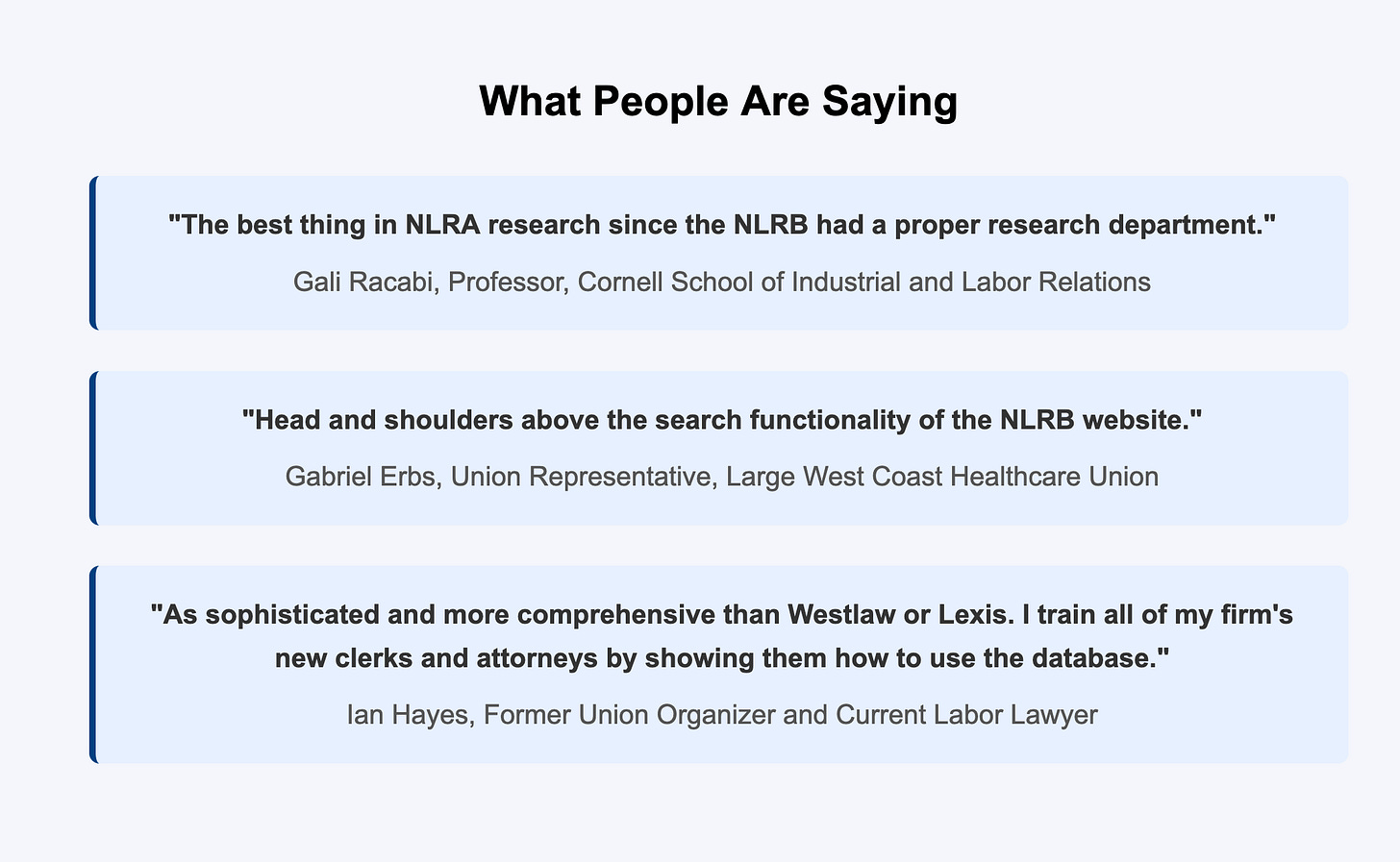NLRB Research Database Improvements
Consider giving me some money!
You can help support the NLRB Research database and keep it available for free to the public by becoming a paid subscriber to NLRB Edge or by becoming a recurring donor directly to NLRB Research ($5/mo, $10/mo, $15/mo, $20/mo).
NLRB Edge has been going long enough as a standalone publication that I suspect many readers are unaware of the fact that it is an outgrowth of a different project I built a couple of years ago and have been maintaining ever since. That project is the NLRB Research database, which has collected over 115,000 NLRA-related legal decisions and other materials into an extremely fast searchable database that automatically updates itself every day with any new documents that come out.
NLRB Research has over 66,000 NLRB decisions that run all the way to the beginning of the agency, over 5,000 ALJ decisions, over 8,000 Regional Election Decisions, over 5,000 OM/GC/Advice memos, every NLRB manual, the briefs the agency files in its injunction and appellate litigation, and so on. I converted all of these documents into plain text, generated an AI summary for each of them, and made it so that they can all be searched simultaneously and quickly. You can search the entire text of the documents, document names, document citations, and so on.
In addition to material produced by the NLRB, the database also contains circuit court and Supreme Court decisions that are related to the NLRA and NLRB. Until recently, I had achieved this by scraping the Justia website. This did not work perfectly, but it did a decent job. A few months ago, Justia blocked my ability to scrape the website, which prevented NLRB Research from grabbing any new circuit court or Supreme Court decisions.
After a couple of months of weighing my options, I decided to just start over with the way that the database gathers circuit court and Supreme Court decisions. I cleared out all of the decisions that had been gathered from Justia and then repopulated the entire database using the Court Listener API. The result of all of this for users is:
The database now contains every Supreme Court and circuit court decision that uses the phrase “National Labor Relations” anywhere in its text. This is more comprehensive than the way the Justia scraping worked and many more Supreme Court and circuit court decisions are now in the database than before. This new approach should capture almost every single decision from these courts that could be relevant to NLRA/NLRB practice.
The citations for the Supreme Court and circuit court decisions are more up-to-date and thus more useful to search for. Justia had good citations for historical cases, but the cases that it added after its initial historical scrape were just posted with docket numbers and not updated when the case received a formal citation. This is not true anymore.
Because I needed to bulk summarize every Supreme Court and circuit court decision, I went ahead and re-summarized every document in the database using Gemini 2.5-flash, which is a more advanced model than the cases had previously been summarized under. This cost a couple hundred dollars, but hopefully the AI summaries are improved.
In the year or so since it has been available to the public, I have gotten many emails from local union staff and union stewards telling me how useful it has been for them. There are a lot of people involved in the labor movement who deal with legal questions from time to time, or even very frequently, who nonetheless do not have access to expensive legal research tools like Westlaw or Lexis. Academics and lawyers also use the database. I am a practicing labor lawyer and I personally use it for all of my NLRB research.
NLRB Research is genuinely a better tool for NLRB/NLRA questions than any other legal research service out there and much better than the NLRB website. Indeed the NLRB is aware of the tool and earlier this year I was contacted by the agency and asked to explain how it works. I have been very glad to be able to make it freely available to the public and continue maintaining and improving it as a passion project.
But it does cost money to run. There is hosting. There are the AI subscriptions. There is my own time, among other things. So if you’d like to help keep the lights on, please do consider becoming a small monthly donor/subscriber. It really does make a difference.
You can help support the NLRB Research database and keep it available for free to the public by becoming a paid subscriber to NLRB Edge or by becoming a recurring donor directly to NLRB Research ($5/mo, $10/mo, $15/mo, $20/mo).

